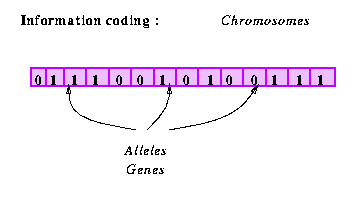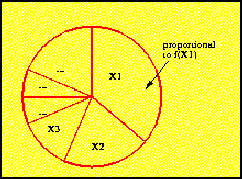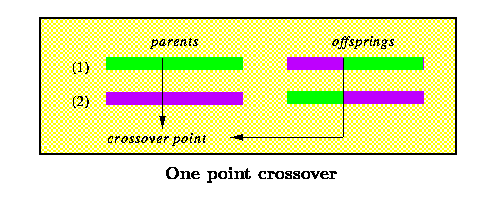|
|
|
|
What is a Genetic Algorithm?A GA, and more generally an Evolutionary Algorithm (EA) mimics natural evolution processes in order to solve computational problems (ususally large, difficult and complex optimization problems). These algorithms evolve a population of potential solutions with help of stochastic operator.
|
Identify the search space
| Design a coding scheme for the points of the search space: genetic
representation
| Design a function to evaluate potential solutions: the fitness
function. The only requirement for this function is to yield a positive
value to the selection process (no continuity nor derivability required).
| The fitness function is maximized during the evolution process. Sucessive
populations of solutions are built, that fit increasingly well. | |
Start from a set of potential solutions: i.e. a population of individuals
| Successively construct new populations, each one being generated from the
previous one with help of stochastic operators: selection and genetic
operators | |

| Genotype: encoding of the parameter(s) as a bit string (there exists other EA based on non binary encoding), also called chromosome. A particular bit of the string is called a gene and the possible values are called alleles (in our case "0" or "1") |

Phenotype: expression of the genotype in the problem context, i.e. a point
of the search space.
| Fitness value: express the quality of the individual with respect to the
problem to be solved | |
Some indivuals are chosen among the population in order to build the next generation. Individuals are randomly chosen according to their fitness value, the high-fitted individuals being often selected. This process can be seen as a succession of roulette-wheel drawings: each individual corresponding to an aera of size proportional to its fitness value.

They are the exploration tools of GA. New individuals are created from the current population. The selection step is intended to choose fit individuals (parents) to be reproduced and the genetic operators create new offsprings from their genetic material. The most commom operators are the one point crossover and the bit-flip mutation :
One point crossover: mixes the genes of the two parents, using a randomly chosen point on the chromosome

Bit-flip mutation: produces a minor perturbation of the genotype. Each gene can be flipped with a small probability pm

There exists numerous classical or problem specific
operators, see for example ![]() for details.
for details.
Consider the following problem: find the maximum of the function
x1 and x2 are the parameters. If we decide to sample the intervalle [0,1] on 8 bits, then the encoding is a 16 bit string, and the fitness function is directly f(x1,x2). An individual has the following characteristics:
genotype: 16 bit sting
| phenotype: the couple (x1,x2), x1 being
decoced from the 8 first bit and x2 from the others.
| fitness value: f(x1,x2) | |
L. Davis. Genetic Algorithms and Simulated Annealing. Pittman, London, 1987.
D. A. Goldberg. Genetic Algorithms in Search, Optimization, and Machine Learning. Addison-Wesley, January 1989.
J. H. Holland. Adaptation in Natural and Artificial System. Ann Arbor, University of Michigan Press, 1975.
J. R. Koza. Genetic Programming. MIT Press, 1992.
Z. Michalewicz. Genetic Algorithms + Data Structures = Evolution Programs. Springer Verlag, 1992.
![]()